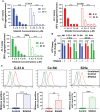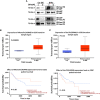Distinct mechanism of cervical cancer cell death caused by the investigational new drug SHetA2
- PMID: 36203464
- PMCID: PMC9531157
- DOI: 10.3389/fonc.2022.958536
Distinct mechanism of cervical cancer cell death caused by the investigational new drug SHetA2
Abstract
Drug-targetable vulnerabilities of cancer cells include their dependence on heat shock proteins (HSPs) to support elevated mitochondrial metabolism and counteract cell death factors. The investigational new drug SHetA2 targets these vulnerabilities in ovarian and endometrial cancer cells by disrupting complexes of the mortalin HSP with its client proteins (mitochondrial support proteins, metabolic enzymes, p53) leading to mitochondrial leakage of cytochrome c and apoptosis-inducing factor (AIF), and caspase-dependent apoptosis. Our objective was to evaluate the roles of mitochondrial damage and another SHetA2-target HSP protein, cytoplasmic heat shock cognate 70 (hsc70), in the mechanism of SHetA2 killing of cervical cancer cells. Cervical cancer cells responded to SHetA2 with excessive mitophagy that did not deter AIF leakage into the cytoplasm. Then, hsc70 was unable to prevent cytoplasmic AIF nuclear translocation and promotion of DNA damage and cell death, because SHetA2 disrupted hsc70/AIF complexes. The Cancer Genome Atlas analysis found that overexpression of hsc70, but not mortalin, was associated with worse cervical cancer patient survival. Use of specific inhibitors documented that AIF and mitophagy, but not caspases, contributed to the mechanism of SHetA2-induced cell death in cervical cancer cells. As validation, excessive mitophagy and lack of caspase activation were observed in SHetA2-inhibited xenograft tumors.
Keywords: SHetA2; apoptosis inducing factor; cell death; cervical cancer; heat shock cognate 70; heat shock protein; mitochondria; mitophagy.
Copyright © 2022 Rai, Chandra, Kennedy, Zuna and Benbrook.
Conflict of interest statement
The authors declare that the research was conducted in the absence of any commercial or financial relationships that could be construed as a potential conflict of interest.
Figures










Similar articles
-
Utility and Mechanism of SHetA2 and Paclitaxel for Treatment of Endometrial Cancer.Cancers (Basel). 2021 May 12;13(10):2322. doi: 10.3390/cancers13102322. Cancers (Basel). 2021. PMID: 34066052 Free PMC article.
-
Mortalin and PINK1/Parkin-Mediated Mitophagy Represent Ovarian Cancer-Selective Targets for Drug Development.Adv Sci (Weinh). 2025 Jul 20:e05592. doi: 10.1002/advs.202505592. Online ahead of print. Adv Sci (Weinh). 2025. PMID: 40685746
-
SHetA2 Attack on Mortalin and Colleagues in Cancer Therapy and Prevention.Front Cell Dev Biol. 2022 Feb 23;10:848682. doi: 10.3389/fcell.2022.848682. eCollection 2022. Front Cell Dev Biol. 2022. PMID: 35281109 Free PMC article. Review.
-
Novel ovarian cancer maintenance therapy targeted at mortalin and mutant p53.Int J Cancer. 2020 Aug 15;147(4):1086-1097. doi: 10.1002/ijc.32830. Epub 2020 Jan 8. Int J Cancer. 2020. PMID: 31845320 Free PMC article.
-
Apoptosis-inducing factor (AIF): a novel caspase-independent death effector released from mitochondria.Biochimie. 2002 Feb-Mar;84(2-3):215-22. doi: 10.1016/s0300-9084(02)01374-3. Biochimie. 2002. PMID: 12022952 Review.
Cited by
-
Pharmacodynamics of Cyclin D1 Degradation in Ovarian Cancer Xenografts with Repeated Oral SHetA2 Dosing.AAPS J. 2023 Dec 12;26(1):5. doi: 10.1208/s12248-023-00874-7. AAPS J. 2023. PMID: 38087107 Free PMC article.
-
Manipulation of metabolic responses enhances SHetA2 efficacy without toxicity in cervical cancer cell lines and xenografts.Gynecol Oncol. 2024 Jan;180:44-54. doi: 10.1016/j.ygyno.2023.11.013. Epub 2023 Dec 5. Gynecol Oncol. 2024. PMID: 38052108 Free PMC article.
-
Heat shock proteins as hallmarks of cancer: insights from molecular mechanisms to therapeutic strategies.J Hematol Oncol. 2024 Sep 4;17(1):81. doi: 10.1186/s13045-024-01601-1. J Hematol Oncol. 2024. PMID: 39232809 Free PMC article. Review.
-
Mitophagy in gynecological malignancies: roles, advances, and therapeutic potential.Cell Death Discov. 2024 Dec 5;10(1):488. doi: 10.1038/s41420-024-02259-x. Cell Death Discov. 2024. PMID: 39639053 Free PMC article. Review.
-
Prevention of hypertension-induced renal vascular dysfunction through a p66Shc-targeted mechanism.Am J Physiol Renal Physiol. 2025 May 1;328(5):F693-F701. doi: 10.1152/ajprenal.00331.2024. Epub 2025 Apr 2. Am J Physiol Renal Physiol. 2025. PMID: 40172516 Free PMC article.
References
Grants and funding
LinkOut - more resources
Full Text Sources
Other Literature Sources
Research Materials
Miscellaneous

